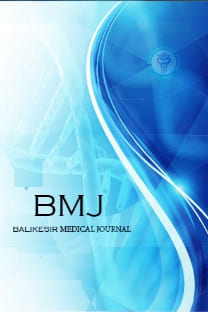Nörofibromatozis tip-1 tanısı ile takip edilen hastalarda beyin dokusunda tanımlanan lezyonların değerlendirilmesinde ADC ağırlıklı görüntülemenin tanıdaki yeri :
___
- Referans[1] Alkan A, Sigirci A, Kutlu R, Ozcan H, Erdem G, Aslan M, et al. Neurofibromatosis type 1: Diffusion weighted imaging findings of brain. Eur J Radiol 2005;56:229–34. doi:10.1016/j.ejrad.2005.05.008.
- Referans[2] Ferraz-Filho JRL, Da Rocha AJ, Muniz MP, Souza AS, Goloni-Bertollo EM, Pavarino-Bertelli ÉC. Diffusion tensor MR imaging in neurofibromatosis type 1: Expanding the knowledge of microstructural brain abnormalities. Pediatr Radiol 2012;42:449–54. doi:10.1007/s00247-011-2274-1.
- Referans[3] Hui ES, Cheung MM, Chan KC, Wu EX. B-value dependence of DTI quantitation and sensitivity in detecting neural tissue changes. Neuroimage 2010;49:2366–74. doi:10.1016/j.neuroimage.2009.10.022.
- Referans[4] Tognini G, Ferrozzi F, Garlaschi G, Piazza P, Patti A, Virdis R, et al. Brain apparent diffusion coefficient evaluation in pediatric patients with neurofibromatosis type 1. J Comput Assist Tomogr 2005;29:298–304. doi:10.1097/01.rct.0000162406.71300.b7.
- Referans[5] Kraut M a, Gerring JP, Cooper KL, Thompson RE, Denckla MB, Kaufmann WE. Longitudinal evolution of unidentified bright objects in children with neurofibromatosis-1. Am J Med Genet A 2004;129A:113–9. doi:10.1002/ajmg.a.20656.
- Referans[6] Van Engelen SJPM, Krab LC, Moll HA, De Goede-Bolder A, Pluijm SMF, Catsman-Berrevoets CE, et al. Quantitative differentiation between healthy and disordered brain matter in patients with neurofibromatosis type I using diffusion tensor imaging. Am J Neuroradiol 2008;29:816–22. doi:10.3174/ajnr.A0921.
- Referans[7] Barbier C, Chabernaud C, Barantin L, Bertrand P, Sembely C, Sirinelli D, et al. Proton MR spectroscopic imaging of basal ganglia and thalamus in neurofibromatosis type 1: Correlation with T2 hyperintensities. Neuroradiology 2011;53:141–8. doi:10.1007/s00234-010-0776-4.
- Referans[8] Karlsgodt KH, Rosser T, Lutkenhoff ES, Cannon TD, Silva A, Bearden CE. Alterations in White Matter Microstructure in Neurofibromatosis-1. PLoS One 2012;7:1–11. doi:10.1371/journal.pone.0047854.
- [Referans9] Filippi CG, Watts R, Duy LAN, Cauley KA. Diffusion-tensor imaging derived metrics of the corpus callosum in children with neurofibromatosis type I. Am J Roentgenol 2013;200:44–9. doi:10.2214/AJR.12.9590.
- Referans[10] Billiet T, Burkhard M, Arco FD, Peeters R, Deprez S, Sunaert S, et al. NeuroImage : Clinical Characterizing the microstructural basis of “ unidentified bright objects ” in neurofibromatosis type 1 : A combined in vivo multicomponent T2 relaxation and multi-shell diffusion MRI analysis. Neuroimage 2014;4:649–58. doi:10.1016/j.nicl.2014.04.005.
- Referans[11] Filippi CG, Watts R, Duy L a N, Cauley K a. Diffusion-tensor imaging derived metrics of the corpus callosum in children with neurofibromatosis type I. Am J Roentgenol 2013;200:44–9. doi:10.2214/AJR.12.9590.
- Referans [12] Hernáiz Driever P, Von Hornstein S, Pietsch T, Kortmann R, Warmuth-Metz M, Emser A, et al. Natural history and management of low-grade glioma in NF-1 children. J Neurooncol 2010;100:199–207. doi:10.1007/s11060-010-0159-z.
- Yayın Aralığı: Yıllık
- Başlangıç: 2017
- Yayıncı: Balıkesir Üniversitesi
Kolesistektomi Spesmenlerimizin Histopatolojik Sonuçları ve Malignite Sıklığı
Gülay TURAN, Figen ASLAN, Eren ALTUN
Erkan ERDEM, Akın USTA, Eren ALTUN, Meriç KARACAN
İNTRAOPERATİF KONSÜLTASYONUN MEME CERRAHİSİ VE SENTİNEL LENF NODU BİYOPSİSİNDEKİ ÖNEMİ
Ferah TUNCEL DALOĞLU, Emre Çağatay KÖSE, Ahmet DAĞ
Palyatif Bakımda Onikomikoz ve Hiperkeratoz Birlikteliği Görülen Bir Olgu Sunumu
Ali Ramazan BENLİ, Cansu KAVRUT, Cansu ŞERİFOĞLU, Alpay AKTÜMEN, Süleyman ERSOY, Didem ADAHAN
ORAL ANTİDİYABETİK PİOGLİTAZONUN KARACİĞER KANSERİ ÜZERİNE ETKİSİ
Mehmet Burak Özkan, Meltem Ceyhan Bilgici, Eser Turgut
Bruton hastalığı zemininde gelişen PML olgusuna pediatrik radyoloji açısından bakış
Mehmet Burak OZKAN, Meltem CEYHAN BİLGİCİ, Alişan YİLDİRAN
Mehmet burak Ozkan, Meltem Ceyhan bilgici
LOKAL PRİLOKAİNE BAĞLI METHEMOGLOBİNEMİ: OLGU SUNUMU
Erkan ERDEM, Akın USTA, Meriç KARACAN
Karbonmonoksit intoksikasyonunun neden olduğu miyokardiyal hasar: Olgu Sunum
Ali GÜR, Kasım TURGUT, Taner GÜVEN, Hakan OĞUZTÜRK, Neslihan YUCEL, Burak Katipoğlu
